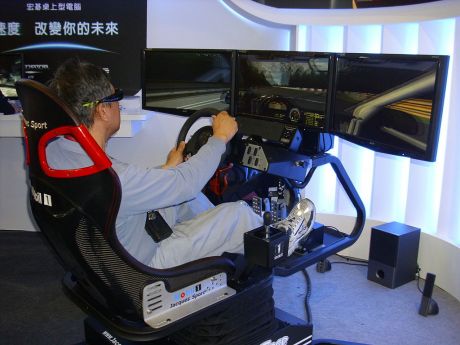New findings to maximise stereoscopic 3D experience

Taipei_IT_Month_Day1_Hall1_Cloud_Technology_Pavilion_3D_Racing_Area
Rico Shen [CC BY-SA 4.0-3.0-2.5-2.0-1.0 (http://creativecommons.org/licenses/by-sa/4.0-3.0-2.5-2.0-1.0)], via Wikimedia Commons
Creating the illusion of depth, stereoscopy offers exciting potential for information visualisation and engaging 3D interactive experiences. An EU-funded project pioneered research on 3D interaction that has hitherto received scant attention.
Although penetration of stereo display devices has been rising steadily
over the last few years, viewer discomfort holds back widespread
embracement of the technology. Vergence-accommodation conflict – a
focusing issue caused by the eyes moving asynchronously – is quoted as a
main contributor to why some people experience discomfort when watching
stereoscopic 3D.
Research within 3STARS (3D stereoscopic interactive user interfaces) greatly helps to overcome this issue. Researchers proposed the concept of indirect multitouch interaction that circumvents the problem of mismatch between the real depth of the display surface and the perceived depth. Viewers can use a tablet that is considered an indirect input device with six degrees of freedom to control the content of the 3D stereoscopic device.
By eliminating the need for touching the display surface, this solution mitigates the risk of missing information by occlusion. It also retains the richness of multitouch interaction and is less prone to context switches than the conventional mouse and keyboard combination.
Researchers compared two indirect techniques designed for the tablet with two state-of-the-art direct touch techniques. Study results showed that participants made 30 % less errors while navigating in the 3D environment, thereby showing the significant role that occlusion plays in direct touch.
3STARS research also focused on how to enhance interactive experience to viewers using head-mounted display devices. Experiencing virtual reality in domestic settings is challenging because of the presence of physical objects and furniture that are not usually defined in the virtual environment.
To address this challenge, researchers explored the concept of substitutional reality. In such environments, every physical object surrounding a user is paired to a virtual counterpart. Users can move within a virtual environment that is radically different from the physical one and still know that everything they see really exists although there is some mismatch. The team identified the factors that introduce mismatch in the pairings and how far mismatch can be pushed before it affects the suspension of disbelief. Based on the results, researchers derived a set of guidelines for designing future substitutional reality experiences.
Project results have been published in peer-reviewed journals.
published: 2016-02-19

